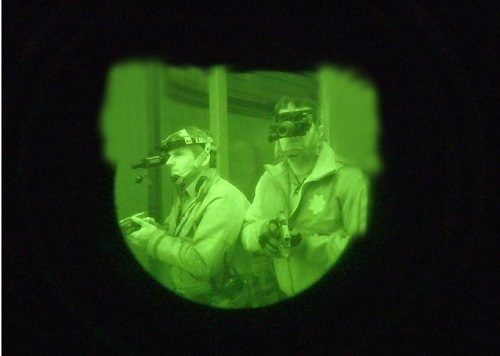If you have ever seen a film in which night vision was practiced, or if you have used a device that takes benefit of this technology to help people see in the dark, you have most probably observed that the picture shown through these devices is always green.
The two come together so nicely that the moment anyone mentions night vision binoculars to you, it immediately brings a green image in front of your eyes.
The advantages of seeing what our eyes can not see in the dark are enormous. For military operations as well as civilian services, night vision technology provides tremendous benefits.
It can help find survivors of natural cataclysms, and it can pinpoint the location of an enemy.
As a layman, you are, however, interested in learning why night vision is green. Let’s make it all clear.
When Was This Technology Invented?
You might be surprised to learn that this technology has been around for some time, used broadly, in World War II.
Both Reich and the US military worked on this technology before and during the war for using it on the battlefield. Both the tank divisions and the infantry used it to identify the location of the enemies.
Although, the night vision technology used over 50 years ago was nothing like the beautiful portable night vision goggles we’re functionally identifying it with. The equipment used during those times was heavy and required manpower to be carried and used in the field.
The notion of making this technology portable, with the possibilities, did not occur on a functional level until the Vietnam War when the US army started to use the first devices that could be worn on a soldier's head.
The main logic that night vision goggles remains the same: it is the use of whatever light is transmitted by the enclosing environment, coupled with image intensification devices.
No matter how superior night vision is now, you should remember that the same original idea that was used during the wars, as mentioned above, continues to stay at its foundation.
So, What exactly makes night vision green?
To know how the green vision occurs, we will need to learn a little more about the technology that is involved.
These technologies are used on goggles, and also in night vision cameras and scopes. They are required for how the green image appears, and we will address them as follows.
Thermal imaging

Thermal imaging is capable of telling the heat signature of an object against the surrounding atmosphere.
To put it differently, it's capable of determining when the target's temperature differs from the rest of the objects around.
Active Illumination
While thermal imaging sounds something that's employed in the military-grade application, illumination is quite straightforward.
The picture intensification used by goggles, or other devices, might require more light input to process and present the picture when you look through them.
The illumination is very near to the infrared band. By putting more light in the environment, the devices make better conditions for the night vision system to harness it and transform it into an image.
Image intensification
We have already mentioned it a couple of times before, and now it is the time to show that this is the tech responsible for the green picture you see via your night vision monocular, goggles, range, or some other similar device. This technology is designed to provide you with the ability to see in the dark.
How Does image intensification create the picture?
What occurs when we look through any vision equipment is the image intensification technology used on the unit takes the light emitted by the celestial bodies and amplifies it. That's the reason we can find a good picture of what surrounds us.
As you can guess by now, it's not feasible for binoculars, monoculars, or goggles to operate in the pitch dark. However, the thing is, the majority of the time, you won’t need your device to work in such away. Complete darkness isn't easy to obtain, so situations that would meet with such conditions are rare.
What About The Green Vision?
When the light photons hit the lens, they consist of all the colors. The matter is that the photons are converted into electrons, and then all the information which might link to colors perceived by our brain turns only into white and black.
The explanation is that the image intensification component is made of phosphorus.
Phosphorus is green, as you may know, and its luminescence capability leads to capture the light from the surrounding environment and present it to you. Therefore, the image you will see is green, as well.
But why is phosphorus used?

It's not by accident that these devices utilize phosphorus. It has to do with something named chromatic sensitivity.
This ability is relevant to how sensitive the human eye is to different colors. From the whole spectrum, the color green is the winner, and that's why night vision goggles and other similar products are created with phosphorus.
To go even deeper, this sensitivity of the eye toward the green color signifies that we see more shades of this color than of any other. What happens when our eyes can tell the differences between the different values of green is that we can see objects and shapes.
Another advantage is that we can tolerate taking a look at the green color for extended periods than at any other color. The computer screens are green for this reason.
And now you know why the night vision showed by different devices produced to help you see in the dark is green, and how that is beneficial for the human eye.